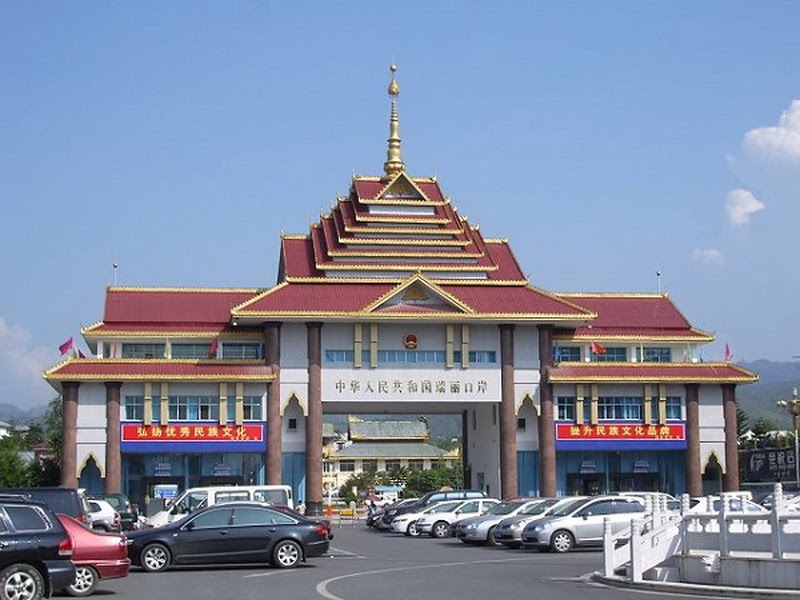
During the Anti-Japanese War, a temporary airport was built here and there were very often takeoffs and landings of the U.S. aircrafts delivering munitions and supplies. It is located in the urban Ruili about 4 km southeast of the Ruili River, with a total area of 2.4 square kilometers closely linked to the state level port—Mujie of Myanmar in the East, south and north.
In 2005, the local residents of Jiegao Border Trade Area account for 2,744 people, while the temporary population was over 5,000 people.

In 1960s, lived here only a dozen Dai families who made up the only village along the southwest bank of China's Ruili River. As Ruili is separated by a river, which results in traffic inconvenience, especially in the rainy season of river skyrocketing, the territory almost breaks off its contact with inner land. Therefore, in the past it is the real "angle to the horizon”.
Jiegao, in 1987, was assessed as China's western focus region of "two-way opening-up system"; in July of 1988, Jiegao Working Committees and Offices was set up; while, on December 26, 1990, Jiegao Border Trade Area was established; in 2000, the Yunnan Provincial Party Committee, and Provincial government declared the setting up of "customs territory" management style to the State Council and received approval, which brought about the first establishment of Trade, Tourism-based Economic Development Experimental Zone in Yunnan approved by the State Council.
Nowadays, the total investment attracted to this tiny piece of land has reached 220 million yuan, of which infrastructure investment 140 million.
Broad streets are orderly; busy transporting vehicles really fly like shuttles, presenting a spectacle; brilliant lights line up along the new street with a length of 1.5 kilometers; all these present quite a scene of Chinese antiquity.
Between the No. 81-1 and No. 82 landmarks, the Chinese side took the lead in building the Chinese side of the Sino-Myanmar Street while, in March of 1991, Myanmar invested 40 million rupiah for building 100 shopping malls of rather Myanmar features on the Burmese side.
An interesting thing is: the Sino-British Street of Sha Tau Kok had become history in 1997, while the Sino-Myanmar Street has only turned the first page. With the surging tide of the reform and opening up policy, various firms and companies from in and outside the prefecture, in and outside the province, from the whole country and even from abroad have sprouted and staged in Jiegao. Over the years, border trade cargoes in and out of the Jiegao port each year accounts for 50% -60% of the province's total import and export volume and more than 30% of landlocked import and export trade volume of the whole country. People going to Jiegao for study and investment are numerous each year.
Jiegao, an old town refurbished taking on a new look, has become an export-oriented economic experimental zone in Yunnan, thus won its name "Shenzhen in Yunnan", a most important port in Southwest of our motherland. It can be predicted that the rapid rise in Jiegao will be an emerging new international business and tourist city, with the border characteristics, ethnic characteristics and modern facilities competing with cities of Shenzhen, Zhuhai and so on.
"Jiegao" is a Dai word, meaning "the old town". It is said that Sinan King of Luchuan built his capital here in the late Yuan Dynasty or the early Ming Dynasty. Thus the town got such a name. During the Anti-Japanese War, Jiegao was a very prosperous town. American planes frequently came here, carrying military supplies. It lies 4 kilometers away from Ruili, and is the only part of Ruili Town on the southeastern bank of the Ruili River, known as "shatoujiao" or "Tianyahaijiao" in the southwest of China.
In 1987 Jiegao became an important port where bilateral trade could be done. In 1991, "Jiegao Border Trade Economic Zone" was set up. China and Burma have built China-Burma Street, which is now filled with stores and shops. Since 1992 the imports and exports from Jiegao have accounted for 50% to 60% of the total imports and exports of the border trade of the province, and over 30% of the imports and exports of the border trade from the inland ports throughout the country. Jiegao Bridge across the Ruili River links Ruili with Jiegao. The bridge is now the longest road bridge in Yunnan and on the boundary line in the Southwest of China. In a word, the booming Jiegao has become a newly- developing business town and border resort with typical ethnic features and modern facilities.
Admission Fee:¥0

You will only receive emails that you permitted upon submission and your email address will never be shared with any third parties without your express permission.
